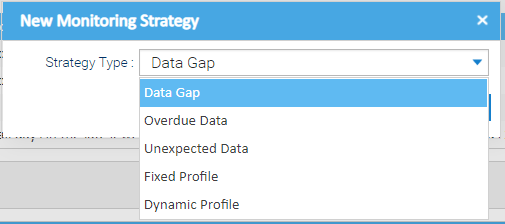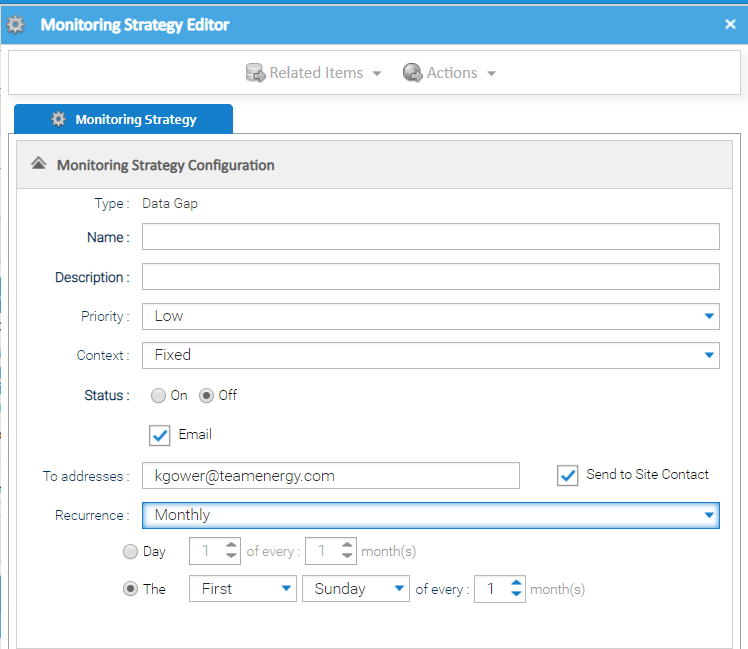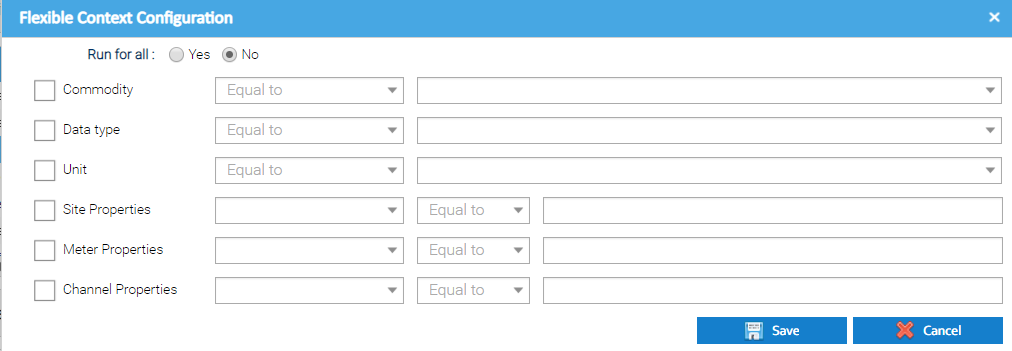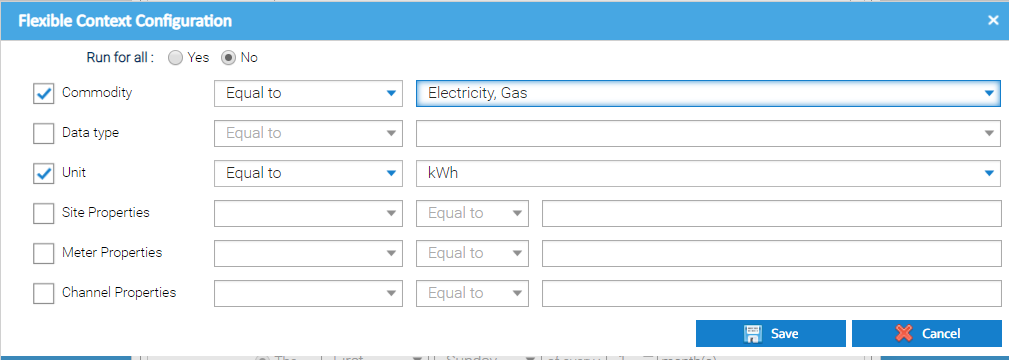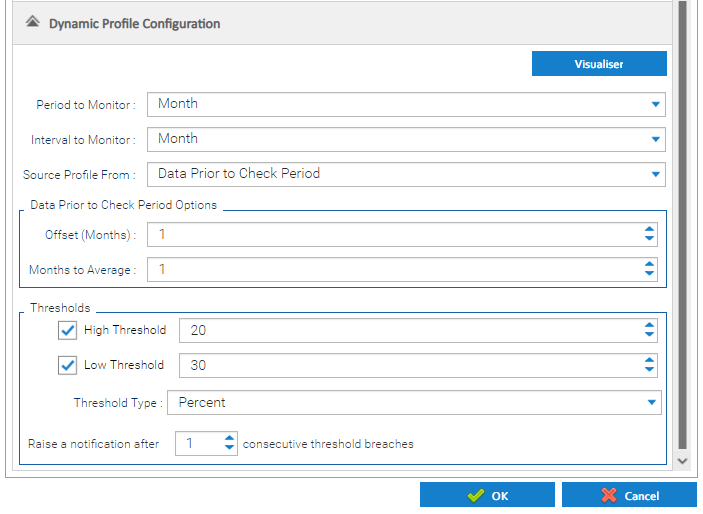Sigma Online User Manual
Creating a Dynamic Trend Profile
Being able to identify potential problems with your utility usage is absolutely critical to help you manage your energy effectively and help detect avoidable waste. The idea is that you set-up a number of monitoring strategies to notify you whenever an unusual pattern is identified on your periodic channels. This is useful in being able to efficiently determine where your energy usage has gone off trend so that investigative or corrective action can be taken quickly to prevent the exception from happening again and avoid potential waste.
A dynamic profile is where recent data is compared with preceding historical data to determine whether the recent usage might be suspect - i.e. the usage has gone 'off trend'. This is commonly known as precedent based targeting. The system will automatically review the data to notify you of these issues to help prompt proactive investigation to determine whether anything needs to change to bring usage back to something more normal. The sensitivity of these checks and how often they should be performed is entirely configurable. This is often referred to as "spike" or "drop" identification.
For example:
- every Monday for the past four weeks has used an average of 100 kWh, but the latest Monday has used 150 kWh.
- the weekly consumption for the previous 2 weeks has been 12,000 kWh, but last week was 15,000 kWh
Adding a Dynamic Profile Strategy
The top section of the Monitoring Strategy Editor is common to all the different monitoring strategy types that can be setup. The details that need to be entered are as follows: The field is disabled and displays the Strategy Type being created Choose the importance of any notifications that are created against this strategy. Available options are: Choose from: Fixed - allows you to drag and drop individual Channels. Click here for more details Flexible - allows you to configure the set up to automatically include Channels, see below for more details Tick if you want Sigma to send summary notifications that are raised on a regular basis. Note, you can also manage a Strategy in Schedule Management Activity if an email address is added Enter email address(s) to send a summary notification to. More than one email address can be entered, and will need to be separated with a comma. Choose from Note, there are more options depending on which of the above you have chosen, see below for more details on the configuration options. It is possible to define which periodic channels the strategy should run for. This will help you ensure your strategies continue to run as your energy estate evolves and assets change/get added. Either: OR The available options are: Commodity, Data type, Unit, Site Property Keys, Meter Property Keys, Channel Property Keys. For example, the above configuration would include all Electricity and Gas Channels that have a unit set to kWh. As new channels that match these parameters are added to your estate, the monitoring strategy would automatically include them when it runs. If you want to be notified of new issues by email, you can choose how often you should get an email and who the email should be sent to. Emails will contain a summary of new notifications that have been raised since the last email was received. It will also contain a summary of all the outstanding notifications. Creating the Strategy
Monitoring Strategy Details
Field Default Details Type N/A Name Empty Enter a name - mandatory Description Empty Enter a description - mandatory Priority Low Context Fixed Status Off Choose On or Off to determine whether the system performs the checks Email Empty To addresses Empty Send to Site Contact Empty Tick if you want to send an email to the Site Contact (entered in the Site Editor) with a summary of notifications that relate to the assets on their site only. Recurrence Monthly Channel Context Configuration
A monitoring strategy can have a "context" of either:Setting up Flexible configuration:
Email Options
Dynamic Profile Configuration
The Monitoring Strategy Editor also contains an Dynamic Profile Configuration section that allows you to set the specific configuration to use when finding and managing your data.
The settings entered here will control how recent data is compared with previous data to determine whether there is an issue. Ultimately, these options provide you with the tools to choose the granularity you want the check to be performed (e.g. aggregated week / day / hour aggregation or half-hourly) and what the system should use as historical data to compare that against.
Whilst each of the fields are explained below in more detail, please click here to jump to a table that provides a some example configurations and (e.g. I want to check a days behaviour with the behaviour on the same days over the last 2 weeks).
| Field | Default | Description |
|---|---|---|
| Period to Monitor | Month | This represents the period of time you want to compare to. Combined with the offset that can be defined, this will determine what the latest data will be compared to. Choose from:
Please note, the period to Monitor selected will drive at what point in time the system will perform the checks and how it determines the latest period of time that is being checked.
|
| Interval to Monitor | Month | This represents the interval within that period that you wish to monitor. The options available in the dropdown will depend on the Period to Monitor that has been chosen. Period: Year
Period: Month
Period: Week
Period: Day
|
| Source Profile From | Data Prior to Check Period | Choose from:
|
Data Prior to Check Period is chosen... compare recent data against the period of time directly prior to the period being checked. | ||
| Offset (<period selected>) | 1 | Specifying a number greater than one here specifies an offset as to how many prior periods should be skipped when determining the period of time to compare the recent behaviour against. By default this would be "1" and this means:
Some examples where the offset may be changed to something other than "1":
|
| <period selected> to Average | 1 | This will define the number of prior periods of time that will be used to derive an average profile which the recent data can then be compared to to determine if it is suspect or not. For example if the period selected is:
|
Data Ending on a Fixed Date is chosen... compare recent data against the period of time directly prior to the end date that has been specified. | ||
| Fixed Date | Current Date | Amend the Fixed date using the arrows or the calendar |
| <period selected> to Average | 1 | As above - it will average the period directly prior to the period ending that has been specified. |
| Thresholds | ||
| High Threshold | 20 | Use the tickbox to the left of the High Threshold label to enable/disable the high threshold check. The value entered here is effectively the sensitivity of the upper limit that is permitted when the recent data is compared against the historical data (i.e. where the data spikes). This should be considered in conjunction with the type of threshold listed below. |
| Low Threshold | 30 | Use the tickbox to the left of the Low Threshold label to enable/disable the low threshold check. The value entered here is effectively the sensitivity of the lower limit that is permitted when the recent data is compared against the historical data (i.e. where the data drops). This should be considered in conjunction with the type of threshold listed below. |
| Threshold Type | Percent | Choose from:
|
| Raise a notification after X consecutive breaches | 1 | This setting allows you to control how sensitive the check is and whether it should only alert you if the issue is a consistent problem. For example, you maybe performing a daily check against the same day last week. You might only want it to tell you if a problem is found 2 days in a row, in this case this would be set to "2". |
Click OK to save the Monitoring Strategy.
Once the Strategy has been set up, Sigma will review the data each night and create any relevant notifications in the Notifications tab
Example Configurations
- Click here to see some example configurations
Managing Dynamic Trend Profiles
- Click here for more information on Managing Dynamic Trend Profiles
@ Copyright TEAM - Energy Auditing Agency Limited Registered Number 1916768 Website: www.teamenergy.com Telephone: +44 (0)1908 690018

